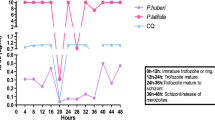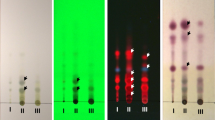Abstract
The aim of the study was to screen 11 selected traditional medicinal plants from West Africa for their in vitro antiplasmodial activity in order to determine the activity of single and of combination of plant extracts and to examine the activity of isolated pure compounds. Ethanolic and aqueous extracts of the 11 selected plants and pure compounds from Phyllanthus muellerianus and Anogeissus leiocarpus were tested in vitro against Plasmodium falciparum 3D7. Proliferation inhibitory effects were monitored after 48 h. Among the plants and pure compounds investigated in this study, geraniin from P. muellerianus, ellagic, gentisic, and gallic acids from A. leiocarpus, and extracts from A. leiocarpus, P. muellerianus and combination of A. leiocarpus with P. muellerianus affected the proliferation of P. falciparum most potently. Significant inhibitory activity was observed in combination of A. leiocarpus with P. muellerianus (IC50 = 10.8 μg/ml), in combination of A. leiocarpus with Khaya senegalensis (IC50 = 12.5 μg/ml), ellagic acid (IC50 = 2.88 μM), and geraniin (IC50 = 11.74 μM). In general growth inhibition was concentration-dependent revealing IC50 values ranging between 10.8 and –40.1 μg/ml and 2.88 and 11.74 μM for plant extracts and pure substances respectively. Comparison with literature sources of in vivo and in vitro toxicity data revealed that thresholds are up to two times higher than the determined IC50 values. Thus, the present study suggests that geraniin from P. muellerianus; ellagic acid, gallic acid, and gentisic acid from A. leiocarpus; and combination of extracts from A. leiocarpus with either P. muellerianus or K. senegalensis could be a potential option for malaria treatment.




Similar content being viewed by others
References
Achenbach H, Waibel R, Mayunga HHN, Weenen H (1992) Antimalarial compounds from Hoslunda opposita. Phytochemistry 31:3781–3784
Agyare C, Niehues M, Lechtenberg M, Deters A, Hensel A (2009) Ethnopharmacological survey and in vitro confirmation of ethnopharmacological use of medicinal plants used for wound healing in Bosomtwi-Atwima-Kwanwoma area, Ghana. J Ethnopharmacol 125:393–403
Agyare C, Lechtenberg M, Deters A, Petereit F, Hensel A (2011) Ellagitannins from Phyllanthus muellerianus (Kuntze) Exell. Geraniin and furosin stimulate cellular activity, differentiation and collagen synthesis of human skin keratinocytes and dermal fibroblasts. Phytomedicine 18:617–624
Agunu A, Abdurahman EM, Andrew GO, Muhammed Z (2005) Diuretic activity of stem bark extracts of Steganotaenia araliacea Hochst (Apiaceae). J Ethnopharmacol 96:471–475
Akah PA, Orisakwe OE, Gamaniel KS, Shittu A (1998) Evaluation of Nigerian traditional medicines: effects of some Nigeria folk remedies on peptic ulcer. J Ethnopharmacol 62:123–127
Asres K, Bucar F, Knauder E, Yardley V, Kendrick H, Croft SL (2001) In vitro antiprotozoal activity of extract and compounds from the stem bark of Combretum molle. Phytother Res 15:613–617
Ayo RG, Audu OT, Amupitan JO (2007) Physico-chemical characterization and cytotoxicit studies of seed extracts of Khaya senegalensis (Desr.). A Juss Afr J Biotechnol 6:894–896
Burkill HM (1997) Useful plants of West Tropical Africa, 2nd edn. Royal Botanic Gardens, Richmond
Curto VE, Kwong C, Hermersdorfer H, Glatt H, Santis C, Virador V, Hearing JV, Dooley PT (1999) Inhibitors of mammalian melanocyte tyrosinase: in vitro comparisons of alkyl esters of gentisic acid with other putative inhibitors. Biochem Pharmacol 57:663–672
Das Gupta R, Krause-Ihle T, Bergmann B, Müller IB, Khomutov AR, Müller S, Walter RD, Lüersen K (2005) 3-Aminooxy-1-aminopropane and derivatives have an antiproliferative effect on cultured Plasmodium falciparum by decreasing intracellular polyamine concentrations. Antimicrob Agents Chemother 29:2857–2864
Dieguez-Hurtado R, Garrido-Garrido G, Prieto-Gonzalez S, Iznaga Y, Gonzalez L, Molina-Torres J, Curini M, Epifano F, Marcotullio MC (2003) Antifungal activity of some Cuban Zanthoxylum specie. Fitoterapia 74:384–386
Dondorp AM, Day NP (2007) The treatment of severe malaria. Trans R Soc Trop Med Hyg 101:633–634
Fall D, Sambou B, Seck M, Wele A, Ndoye I, Gleye C, Laurens A (2008) Enhancing the anthelminthic activity roots of Annona senegalensis. Dakar Med 53:61–67
Fivelman QL, Adagu IS, Warhurst DC (2004) Modified fixed-ratio isobologram method for studying in vitro interactions between atovaquone and proguanil or dihydroartemisinin against drug-resistant strains of Plasmodium falciparum. Antimicrob Agents Chemother 48:4097–4102
Gansane A, Sanon S, Ouattara LP, Traoré A, Hutter S, Ollivier E, Azas N, Traore AS, Guissou IP, Sirima SB, Nebié I (2010) Antiplasmodial activity and toxicity of crude extracts from alternatives parts of plants widely used for the treatment of malaria in Burkina Faso: contribution for their preservation. Parasitol Res 106:335–340
Kabore A, Tamboura HH, Traore A, Traore A, Meda R, Kiendrebeogo M, Belem AMG, Sawadogo L (2010) Phytochemical analysis and acute toxicity of two medicinal plants (Anogeissus leiocarpus and Daniellia oliveri) used in traditional veterinary medicine in Burkina Faso. Arch Appl Sci Res 2:47–52
Lino A, Deogracious O (2006) The in-vitro antibacterial activity of Annona senegalensis, Securidacca longipendiculata and Steganotaenia araliacea Ugandan medicinal plants. Afr Health Sci 6:31–35
Marquez L, Aguero J, Hernandez I, Garrido G, Martinez I, Dieguez R, Prieto S (2005) Anti-inflammatory evaluation and phytochemical characterization of some plants of the Zanthoxylum genus. Acta Farmaceutica Bonaerense 24:325–330
Müller IB, Wu F, Bergmann B, Knöckel J, Walter RD, Gehring H, Wrenger C (2009) Poisoning pyridoxal 5-phosphate-dependent enzymes: a new strategy to target the malaria parasite Plasmodium falciparum. PLoS One 4:1–9
Ndjonka D, Agyare C, Lüersen K, Djafsia B, Achukwi D, Nukenine EN, Hensel A, Liebau E (2011) In vitro activity of Cameroonian and Ghanaian medicinal plants on parasitic (Onchocerca ochengi) and free-living (Caenorhabditis elegans) nematodes. J Helminthol 85:304–312
Noedl H, Se Y, Schaecher K, Smith BL, Socheat D, Fukuda MM (2008) Evidence of artemisinin-resistant malaria in western Cambodia. New Engl J Med 359:2619–2620
Nour AM, Khalid SA, Kaiser M, Brun R, Abdallah WE, Schmidt TJ (2009) The antiprotozoal activity of sixteen Asteraceae species native to Sudan and bioactivity-guided isolation of xanthanolides from Xanthium brasilicum. Planta Med 75:1363–1368
Rajalakshmi K, Devaraj H, Devaraj NS (2001) Assessment of the no-observed-adverse-effect level (NOAEL) of gallic acid in mice. Food Chem Toxicol 39:919–922
Rowe AK, Rowe SY, Snow RW, Korenromp EL, Schellenberg JR (2006) The burden of malaria mortality among African children in the year 2000. Int J Epidemiol 35:691–704
Shuaibu MN, Wuyep PA, Yanagi T, Hirayama K, Tanaka T, Kouno I (2008) The use of microfluorometric method for activity-guided isolation of antiplasmodial compound from plant extracts. Parasitol Res 102:1119–1127
Smith RA, Pontiggia L, Waterman C, Lichtenwalner M, Wasserman J (2009) Comparison of motility, recovery, and methyl-thiazolyl-tetrazolium reduction assays for use in screening plant products for anthelmintic activity. Parasitol Res 105:1339–1343
Snow RW, Guerra CA, Noor AM, Myint HY, Hay SI (2005) The global distribution of clinical episodes of Plasmodium falciparum malaria. Nature 434:214–217
Soh NP, Witkowski B, Olagnier D, Nicolau LM, Garcia-Alvarez MC, Berry A, Vical BF (2009) In vitro and in vivo properties of ellagic acid in malaria treatment. Antimicrob Agents Chemother 53:1100–1106
Sturm N, Hu Y, Zimmermann H, Fritz-Wolf K, Wittlin S, Rahlfs S, Becker K (2009) Compounds structurally related to ellagic acid show improved antiplasmodial activity. Antimicrob Agents Chemother 53:622–630
Tona GL, Cimanga RK, Kambu OK, Totte J, Pieters L, Vlietinck AJ (2009) Phytochemical screening and in vitro antiamoebic activity of extracts from some antidiarrhoeal medicinal plants used in Kinshasa, Democratic Republic of Congo. Recent Prog Med Plant 25:209–224
Trager W, Jensen JD (1976) Human malaria parasites in continuous culture. Science 193:673–675
Wellems TE (2002) Plasmodium chloroquine resistance and the search for a replacement antimalarial drug. Science 298:124–126
WHO (2003) Fact sheet No. 134, Revised May. Traditional medicine. WHO, Geneva
WHO (2007) Available at www.who.int/mediacentre/factsheets/fs094/en/index.html
WHO (2008) World malaria report. WHO, Geneva, p 10
Zirihi GN, Mambu L, Guédé-Guina F, Bodo B, Grellier P (2005) In vitro antiplasmodial activity and cytotoxicity of 33 West African plants used for treatment of malaria. J Ethnopharmacol 98:281–285
Acknowledgments
This research was supported by the fellowship of the Alexander von Humboldt Foundation to D. Ndjonka and of the DAAD to C. Agyare. Further support was provided by the Deutsche Forschungsgemeinschaft, grant LI 793/5-1 to the Cameroonian–German Cooperation Project, http://www.cameroon.uni-muenster.de. C. Wrenger is a “Jovem Pesquisador” of the Fundação de Amparo à Pesquisa do Estado de São Paulo (2009/54325-2).
Author information
Authors and Affiliations
Corresponding author
Rights and permissions
About this article
Cite this article
Ndjonka, D., Bergmann, B., Agyare, C. et al. In vitro activity of extracts and isolated polyphenols from West African medicinal plants against Plasmodium falciparum . Parasitol Res 111, 827–834 (2012). https://doi.org/10.1007/s00436-012-2905-y
Received:
Accepted:
Published:
Issue Date:
DOI: https://doi.org/10.1007/s00436-012-2905-y




